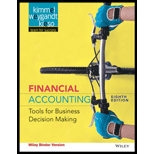
(a)
Inventory turnover ratio: This is a financial measure that is used to evaluate as to how many times a company sells or uses its inventory during an accounting period. It is calculated by using the following formula:
Days’ sales in inventory: Days’ sales in inventory are used to determine number of days a particular company takes to make sales of the inventory available with them.
Gross profit rate is the financial ratio that evaluates the money left over out of the total revenues after deducting the cost of goods sold. Thus, it shows the relationship between the gross profit and net sales. It is calculated by using the following formula:
To Calculate:
- The inventory turnover for 2016, and 2017 of Company Z.
- The days in inventory of Company Z for 2016, and 2017.
- The gross profit rate of Company Z for 2016, and 2017.
(a)
Explanation of Solution
Calculate the inventory turnover of Company Z for 2016.
Cost of goods sold = $1,288,000
Average inventory = $450,000 (1)
Calculate the inventory turnover of Company Z for 2017.
Cost of goods sold = $1,552,000
Average inventory = $560,500 (2)
Working Notes:
Calculate the average inventory for 2016.
Beginning inventory = $332,000
Ending inventory = $568,000
Calculate the average inventory for 2017.
Beginning inventory = $568,000
Ending inventory = $553,000
Calculate days in inventory of Company Z for 2016.
Total number of days = 365
Inventory turnover, 2016 = 2.86 times (a)
Calculate days in inventory of Company Z for 2017.
Total number of days = 365
Inventory turnover, 2016 = 2.77 times (a)
Calculate gross profit rate of Company Z for 2016.
Gross profit = $437,000 (3)
Sales revenue = $1,725,000
Calculate gross profit rate of Company Z for 2017.
Gross profit = $396,000 (4)
Sales revenue = $1,948,000
Working Notes:
Calculate the gross profit for 2016.
Sales revenue = $1,725,000
Cost of goods sold = $1,288,000
Calculate the gross profit for 2017.
Sales revenue = $1,948,000
Cost of goods sold = $1,552,000
Therefore, the inventory turnover of Company Z for 2016, and 2017 are 2.86 times, and 2.77 times respectively.
Therefore, the days in inventory for 2016, and 2017 are 128 days, and 132 days respectively.
Therefore, the gross profit rate of Company Z for 2016, and 2017 are 25.33%, and 20.33% respectively.
(b)
To Explain: Whether the liquidity and profitability of Company Z improve or deteriorate in 2017
(b)
Explanation of Solution
Based on the inventory turnover ratio and days’ in inventory are fluctuating in nature. Therefore, the liquidity of the company has deteriorated in the year 2016 and improved in the year 2017.
Based on the gross profit ratio, the profitability of the company has decreased.
Want to see more full solutions like this?
Chapter 6 Solutions
Financial Accounting 8th Edition
- Maxwell’s Bike Repair Services started the year with total assets of $400,000 and total liabilities of $240,000. During the year, the business recorded $620,000 in repair revenues and $410,000 in expenses. Maxwell paid dividends of $60,000. What is the value of stockholders’ equity at the end of the year?arrow_forwardCan you solve this financial accounting question using valid financial methods?arrow_forwardWhat were the liabilities at December 31?arrow_forward
 Financial AccountingAccountingISBN:9781305088436Author:Carl Warren, Jim Reeve, Jonathan DuchacPublisher:Cengage LearningPrinciples of Accounting Volume 1AccountingISBN:9781947172685Author:OpenStaxPublisher:OpenStax College
Financial AccountingAccountingISBN:9781305088436Author:Carl Warren, Jim Reeve, Jonathan DuchacPublisher:Cengage LearningPrinciples of Accounting Volume 1AccountingISBN:9781947172685Author:OpenStaxPublisher:OpenStax College Managerial Accounting: The Cornerstone of Busines...AccountingISBN:9781337115773Author:Maryanne M. Mowen, Don R. Hansen, Dan L. HeitgerPublisher:Cengage Learning
Managerial Accounting: The Cornerstone of Busines...AccountingISBN:9781337115773Author:Maryanne M. Mowen, Don R. Hansen, Dan L. HeitgerPublisher:Cengage Learning EBK CONTEMPORARY FINANCIAL MANAGEMENTFinanceISBN:9781337514835Author:MOYERPublisher:CENGAGE LEARNING - CONSIGNMENT
EBK CONTEMPORARY FINANCIAL MANAGEMENTFinanceISBN:9781337514835Author:MOYERPublisher:CENGAGE LEARNING - CONSIGNMENT Managerial AccountingAccountingISBN:9781337912020Author:Carl Warren, Ph.d. Cma William B. TaylerPublisher:South-Western College Pub
Managerial AccountingAccountingISBN:9781337912020Author:Carl Warren, Ph.d. Cma William B. TaylerPublisher:South-Western College Pub





